Physical and Quantum Optics
In This Chapter:
✔ Interference
✔ Diffraction
✔ Polarization
✔ Quantum Theory of Light
✔ X-rays
Interference
In examining the reflection and refraction of light, it is sufficient to consider light as though it consisted of rays that travel in straight lines in a uniform medium. The study of such phenomena, therefore, is called geometrical optics. Other phenomena, notably interference, diffraction, and polarization, can be understood only in terms of the wave nature of light, and the study of these phenomena is called physical optics.
Interference occurs when waves of the same nature from different sources meet at the same place. In constructive interference, the waves are in phase (“in step”) and reinforce each other; in destructive interference, the waves are out of phase and partially or completely cancel (Fig- ure 20-1). All types of waves exhibit interference under appropriate cir-
Figure 20-1
cumstances. Thus, water waves interfere to produce the irregular surface of the sea, sound waves close in frequency interfere to produce beats, and light waves interfere to produce the fringes seen around the images formed by optical instruments and the bright colors of soap bubbles and thin films of oil on water.
Solved Problem 20.1 When is it appropriate to think of light as consisting of waves and when as consisting of rays?
Solution. When paths or path differences are involved whose lengths are comparable with the wavelengths found in light, the wave nature is significant and must be taken into account. Thus, diffraction and interference can be understood only on a wave basis. When paths are involved that are many wavelengths long and neither diffraction not interference occurs, as in reflection and refraction, it is more convenient to consider light as consisting of rays.
Diffraction
The ability of a wave to bend around the edge of an obstacle is called dif- fraction. Owing to the combined effects of diffraction and interference, the image of a point source of light is always a small disk with bright and dark fringes around it. The smaller the lens or mirror used to form the im- age, the larger the disk. The angular width in radians of the image disk of a point source is about
where λ is the wavelength of the light and D is the lens or mirror diameter. The images of objects closer than q0 will overlap and hence cannot be resolved no matter how great the magnification produced by the lens or mirror. In the case of a telescope or microscope, D refers to the diam- eter of the objective lens. If two objects d0 apart that can just be resolved at a distance L from the observer, the angle in radians between them is q0 = d0/L, so the above formula can be rewritten in the form Polarization
Polarization
A polarized beam of light is one in which the electric fields of the waves are all in the same direction. If the electric fields are in random directions (though, of course, always in a plane perpendicular to the direction of propagation), the beam is unpolarized.
You Need to Know
Various substances affect differently light with different directions of polarization, and these sub- stances can be used to prepare devices that permit only light polarized in a certain direction to pass through them.
Quantum Theory of Light
Certain features of the behavior of light can be explained only on the basis that light consists of individual quanta, or photons. The energy of a photon of light whose frequency is f is
Quantum energy = E = hf
where h is Planck’s constant:
Planck’s constant = h = 6.63 × 10−34 J·s
A photon has most of the properties associated with particles—it is localized in space and possesses energy and momentum—but it has no mass. Photons travel with the velocity of light.
The electromagnetic and quantum theories of light complement each other: Under some circumstances, light exhibits a wave character, under other circumstances, it exhibits a particle character. Both are aspects of the same basic phenomenon.
X-Rays
X-rays are high frequency electromagnetic waves produced when fast electrons impinge on a target. If the electrons are accelerated through a potential difference of V, each electron has the energy KE = eV. If all this energy goes into creating an X-ray photon, then
eV = hf
Electron kinetic energy = X-ray photon energy
and the frequency of the X-rays is f = eV/h.

![McGraw-Hill,.Schaum's Easy Outline of Applied Physics Crash Course.[2003.ISBN0071398783]_Page_140_Image_0001 McGraw-Hill,.Schaum's Easy Outline of Applied Physics Crash Course.[2003.ISBN0071398783]_Page_140_Image_0001](http://lh4.ggpht.com/-ZXBmCs431i0/VE6NRdkgicI/AAAAAAAAsBg/fMEvAnsp698/McGraw-Hill%25252C.Schaum%252527s%252520Easy%252520Outline%252520of%252520Applied%252520Physics%252520Crash%252520Course.%25255B2003.ISBN0071398783%25255D_Page_140_Image_0001_thumb.jpg?imgmax=800)
